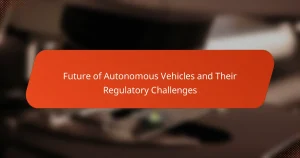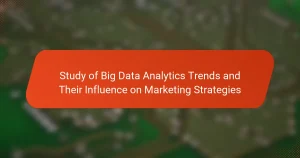Artificial Intelligence (AI) plays a crucial role in job automation and the evolving dynamics of the workforce. AI technologies are increasingly automating routine tasks, which enhances efficiency but also poses the risk of displacing up to 800 million jobs by 2030, particularly affecting low-skill roles. However, AI is also a catalyst for job creation, with the World Economic Forum estimating that 133 million new roles in tech and data analysis could emerge by 2022. As the job landscape transforms, continuous learning and skill adaptation become vital for workers to thrive in an AI-driven economy.

What is the impact of Artificial Intelligence on job automation and workforce dynamics?
Artificial Intelligence significantly impacts job automation and workforce dynamics. AI technologies automate routine tasks, leading to increased efficiency. For instance, a McKinsey report states that up to 800 million jobs could be displaced by automation by 2030. This displacement affects low-skill jobs the most, as machines can perform these tasks more efficiently. Conversely, AI also creates new job opportunities in tech and data analysis sectors. The World Economic Forum predicts that AI could generate 133 million new roles globally by 2022. Workforce dynamics shift as employees need to adapt to new skills and roles. Continuous learning becomes essential for workers to remain competitive in an AI-driven market.
How is Artificial Intelligence transforming job automation?
Artificial Intelligence is transforming job automation by enhancing efficiency and accuracy in various tasks. AI technologies, such as machine learning and robotics, are increasingly capable of performing repetitive and data-driven jobs. This shift leads to reduced operational costs for businesses. For instance, a McKinsey report indicates that up to 45% of current work activities could be automated with existing technologies. Furthermore, AI can analyze large datasets faster than humans, improving decision-making processes. As a result, companies are adopting AI to streamline workflows and optimize productivity. This transformation also necessitates a shift in workforce skills, emphasizing the need for training in AI-related fields.
What are the key technologies driving AI in job automation?
Key technologies driving AI in job automation include machine learning, natural language processing, and robotic process automation. Machine learning enables systems to learn from data and improve over time. This technology is essential for predictive analytics and decision-making processes. Natural language processing allows machines to understand and interpret human language. This facilitates tasks such as customer service automation and content generation. Robotic process automation automates repetitive tasks by mimicking human actions. This technology is widely used in data entry and processing. These technologies collectively enhance efficiency and reduce operational costs in various industries. According to a McKinsey report, automation could displace up to 30% of the global workforce by 2030, highlighting the significance of these technologies.
How does AI enhance efficiency in various job sectors?
AI enhances efficiency in various job sectors by automating repetitive tasks and optimizing workflows. In manufacturing, AI systems streamline production lines, reducing downtime and increasing output. In healthcare, AI algorithms assist in diagnostics, improving accuracy and speeding up patient care. In finance, AI analyzes large datasets for risk assessment, enabling quicker decision-making. In customer service, AI chatbots provide instant responses, enhancing user satisfaction. According to McKinsey, AI could increase productivity by up to 40% in some sectors. These improvements lead to cost savings and allow human workers to focus on more complex tasks.
What are the implications of job automation on the workforce?
Job automation significantly impacts the workforce by displacing certain jobs while creating new opportunities. Many routine and manual tasks are increasingly performed by machines. This shift can lead to job loss in sectors like manufacturing and retail. According to a report by McKinsey, up to 800 million jobs could be displaced globally by 2030 due to automation. However, automation also generates demand for new roles in technology and maintenance. The workforce may need to adapt through reskilling and upskilling to meet these new job requirements. Automation can enhance productivity and efficiency, leading to economic growth. Nevertheless, it may also exacerbate income inequality if not managed properly.
How does job automation affect employment rates?
Job automation generally leads to a decrease in employment rates for certain sectors. Automated systems can perform tasks more efficiently than human workers. This results in job displacement, particularly in repetitive and manual roles. According to a report by McKinsey, up to 800 million jobs could be lost globally by 2030 due to automation. However, job automation can also create new job opportunities in technology and maintenance sectors. The net effect on employment rates varies by industry and region. Overall, while some jobs are lost, others may emerge, leading to a complex shift in the labor market.
What types of jobs are most vulnerable to automation?
Jobs that involve repetitive tasks are most vulnerable to automation. This includes roles in manufacturing, data entry, and customer service. Positions such as assembly line workers are at high risk due to their predictable tasks. Similarly, jobs that require routine data processing, like clerks, face significant automation threats. Research shows that up to 47% of U.S. jobs could be automated in the next two decades. According to a study by McKinsey & Company, jobs with high automation potential often involve physical activities in predictable environments. Roles that require minimal social interaction are also more susceptible. These factors contribute to the increased likelihood of automation in these job sectors.
What are the benefits and challenges of AI-driven job automation?
AI-driven job automation offers significant benefits and challenges. Benefits include increased efficiency and productivity. Automation can perform repetitive tasks faster than humans. This leads to cost savings for businesses. Employees can focus on more complex tasks requiring creativity and problem-solving. According to a McKinsey report, automation could raise global productivity by 0.8 to 1.4 percent annually.
Challenges include job displacement and skill gaps. Many workers may lose their jobs due to automation. This can lead to economic inequality. Workers may require retraining to adapt to new job demands. A World Economic Forum report predicts that 85 million jobs may be displaced by 2025. However, it also forecasts the creation of 97 million new roles. Balancing these impacts is crucial for workforce dynamics.
What advantages does AI bring to businesses in terms of workforce dynamics?
AI enhances workforce dynamics by improving efficiency and productivity. It automates repetitive tasks, allowing employees to focus on higher-value activities. This leads to better job satisfaction and engagement. AI also enables data-driven decision-making, which optimizes resource allocation. According to a McKinsey report, businesses using AI can increase productivity by up to 40%. Furthermore, AI facilitates personalized employee training, enhancing skill development. This adaptability helps organizations respond to market changes swiftly. Overall, AI fosters a more agile and motivated workforce.
What challenges do employees face due to job automation?
Employees face significant challenges due to job automation. One primary challenge is job displacement. Automation can lead to the elimination of positions, particularly in repetitive tasks. For instance, a report by McKinsey estimates that up to 800 million jobs could be displaced by automation by 2030.
Another challenge is skill gaps. Employees may lack the necessary skills to transition into new roles created by automation. A World Economic Forum report highlights that 54% of all employees will require significant reskilling by 2022.
Additionally, there is increased job insecurity. Employees may experience anxiety over their job stability as automation technologies evolve. This can lead to decreased morale and productivity.
Lastly, there is a potential for wage stagnation. As automation increases efficiency, employers may not feel the need to raise wages. This can impact overall economic growth and employee satisfaction.
How do companies adapt to changes brought by AI and automation?
Companies adapt to changes brought by AI and automation through workforce reskilling and process optimization. They invest in training programs to equip employees with new skills relevant to automated technologies. This approach helps mitigate job displacement caused by automation. Companies also implement AI tools to enhance productivity and efficiency in operations. Data from a McKinsey report indicates that 87% of companies are experiencing skill gaps due to AI advancements. Additionally, firms may restructure job roles to incorporate AI, creating hybrid positions that combine human oversight with automated processes. By embracing these strategies, companies remain competitive in an evolving technological landscape.
What strategies can businesses implement to retrain employees?
Businesses can implement several strategies to retrain employees effectively. First, they can offer online courses tailored to specific skills. These courses can be accessed at any time, allowing flexibility for employees. Second, businesses can organize in-house workshops led by industry experts. This approach promotes hands-on learning and immediate application of new skills. Third, mentorship programs can be established, pairing experienced employees with those needing retraining. This fosters knowledge transfer and personal development. Fourth, businesses can utilize simulation-based training. This method enhances practical skills in a controlled environment. Finally, continuous feedback mechanisms should be integrated into the retraining process. Regular assessments can help identify areas for improvement and adjust training accordingly. These strategies collectively enhance workforce adaptability in the face of job automation driven by artificial intelligence.
How can organizations foster a culture of continuous learning?
Organizations can foster a culture of continuous learning by implementing structured training programs. These programs should focus on skill development relevant to evolving job roles. Regular workshops and seminars can enhance knowledge sharing among employees. Encouraging mentorship relationships also promotes a learning environment. Providing access to online courses and resources supports self-directed learning. Recognizing and rewarding learning achievements motivates employees to engage in continuous education. Lastly, creating a safe space for feedback encourages open discussions about learning opportunities. Research shows that companies with a strong learning culture are more adaptable to change and innovation.
What future trends can we expect in AI and job automation?
Future trends in AI and job automation include increased integration of AI in various industries. Automation will likely expand into sectors such as healthcare, manufacturing, and finance. AI systems will improve efficiency by handling repetitive tasks and data analysis. The demand for skilled workers to manage AI technologies will rise. Additionally, remote work will become more prevalent due to AI tools facilitating communication and collaboration. Companies will focus on reskilling employees to adapt to changing job roles. Ethical considerations around AI deployment will gain prominence, influencing regulations and workplace policies. These trends are supported by studies indicating that AI could create 133 million new jobs by 2022, according to the World Economic Forum.
How might AI evolve in its role within the workforce?
AI will evolve in the workforce by increasing automation capabilities. It will take over repetitive tasks, allowing human workers to focus on complex problem-solving. Enhanced machine learning algorithms will improve decision-making processes. AI tools will become more integrated into daily operations across various industries. This shift is expected to create new job categories that require advanced technical skills. According to a report by McKinsey, automation could displace 75 million jobs by 2022 but also create 133 million new roles. Therefore, the workforce will need to adapt through reskilling and upskilling initiatives. Overall, AI’s role will transition from supporting tasks to driving strategic initiatives.
What are the potential societal impacts of widespread automation?
Widespread automation can significantly alter societal structures. It may lead to job displacement across various sectors. Many routine tasks currently performed by humans could be automated. This shift can create economic disparities as low-skilled workers face unemployment. Conversely, automation can also generate new job opportunities in tech and maintenance fields. Education and retraining will become essential for adapting to these changes. Studies indicate that up to 800 million jobs could be displaced by 2030 due to automation (McKinsey Global Institute). This transformation might also affect social interactions and community engagement as work environments evolve.
What practical steps can individuals take to thrive in an automated job market?
Individuals can thrive in an automated job market by developing adaptable skills. This includes focusing on technical skills relevant to automation, such as programming and data analysis. Additionally, enhancing soft skills like problem-solving and creativity is essential. Continuous learning through online courses and workshops can keep skills updated. Networking within industries can provide insights into emerging job opportunities. Seeking roles that require human interaction or complex decision-making can also be beneficial. Research shows that jobs emphasizing interpersonal skills are less likely to be automated. According to a 2021 McKinsey report, up to 25% of current work tasks could be automated, highlighting the need for skill diversification.
The main entity of the article is Artificial Intelligence (AI) and its impact on job automation and workforce dynamics. The article explores how AI technologies automate routine tasks, potentially displacing up to 800 million jobs by 2030 while simultaneously creating new opportunities in tech and data analysis. It discusses key technologies driving AI automation, the implications for employment rates, and the challenges faced by workers, such as skill gaps and job displacement. Additionally, the article highlights strategies for companies to adapt through reskilling and fostering a culture of continuous learning, as well as the future trends in AI and its societal impacts.




